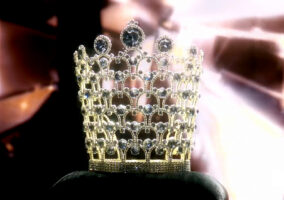 Jenna Coleman and Peter Capaldi in BBC America’s “Doctor Who”
Jenna Coleman and Peter Capaldi in BBC America’s “Doctor Who”
Let’s just get this right out there up front: this was occasionally disappointing; as an episode, as a season premiere, and especially, as an introduction to a new Doctor. But we also want to quickly follow that up by noting that it was, paradoxically, also a very meaty introduction. It was possibly the strongest, clearest mission statement any Doctor ever got to make upon donning his new togs. It also had moments of great finesse and entertainment; delightful bits of character or dialogue that lit up the screen, introductions to new mysteries and concepts, and most interesting of all, the most intensive examination of the psychological processes of regeneration, both in the person doing the regenerating and the people closest to them who have to deal with the repercussions. We laughed, we fidgeted with boredom, we clapped, we rolled our eyes. “Spotty” is the word; uneven, inconsistent. To which the more joyous, easily pleased, nerdier sides of our brains laugh and shout “It’s DOCTOR WHO! What did you expect?”
True that.
There were some stretches that went on too long or were ill-conceived (basically, almost all the scenes with Peter Capaldi in a nightgown until his eyebrows speech), and certain aspects of the episode were underwhelming, like the cringe-worthy dinosaur effects (“It’s DOCTOR WHO! What did you expect?”), or the somewhat limp use of the Paternoster Gang, which sadly, like all of executive producer Steven Moffat’s creations, from River Song to the Weeping Angels, demonstrate drastically diminishing returns over time. “I’m a gay lizard and this is my wife! I’m a gay lizard and this is my wife! I’m a gay lizard and this is my wife!” New Rule: Everything Moffat creates for the Whoniverse should only get three or four episodes and they’re out of the story. Tell us that wouldn’t have improved certain things in prior seasons.
But this episode, by the time it ended, convinced us this was all probably the best direction for Moffat to go after the extremely messy and disappointing season seven, which essentially squandered Matt Smith’s considerable talent on a lot of shouting and spastic hand-waving and replaced Amy Pond with the show’s very first cut-out paper doll companion, Clara. Charming girl, but as generic as a Who companion could get – and by the end of the season, she’d been somewhat unfairly granted a huge place in the Doctor’s life story. Moffat took a shortcut with Clara last season. Instead of developing a relationship with the Doctor, the way Rose, Martha, Donna, Amy and Rory did, she had one inserted into her story. The Impossible Girl became The Girl Who Met And Saved Every Version of the Doctor Throughout His Entire Lifespan Offscreen. By the time she got him to drastically alter universal history (as well as his own timeline) by tearing up just a tiny little bit in The Day of The Doctor, she’d become the Mary Sue to end all Mary Sues. We figured it was time to hit the reset button with this new season, but we were surprised Moffat chose to do some actual retconning of the past before letting go of it. In this new version of the Eleven/Clara dynamic, she was a controlling egomaniac and he was a silly old man with a facelift, trying to get a girl to like him.
THAT is the needle scratch to end all needle scratches.
No, this is not really born out by any viewing of the episodes last season. Sure, they had an annoyingly flirtatious banter, and Moffat had Clara mention, under influence of something called a “truth field” that she fancied The Doctor at the end of last season, but in the rewriting, the tale became apparently more complicated – and considerably darker. In this new version, she liked having a near-immortal being at her beck and call, trying to impress her, and he played the part of a young man because he thought he was supposed to make her like him. It wasn’t romantic; it was codependent and dysfunctional.
Now, here’s a couple of things about that. First, Moffat’s issues with women come through loud and clear in all his Who and most of his Sherlock work. Too many references to list here, but you can find some in our previous DW reviews. Suffice it to say, his male protagonists tend to have lots of dialogue about how silly, manipulative and pointless women can be, in their (his) opinion. Clara went from being Mary Sue to being, well, a shallow ballbuster. Character development on this paper-thin character is welcome, but we’re wary because of Moffat’s history. And while we found at least half of Matt Smith’s episodes to be disappointing because they squandered his talent, we found ourselves annoyed that the very man responsible for that squandering rewrote the entire thing to make Matt Smith’s version of the Doctor look silly in retrospect.
And if you want to get typically nerdy about it – and why wouldn’t you? – a lot of the conflict between Clara and Twelve, which mostly comes down to her having a lot of trouble accepting his new face, only works if you completely ignore that Clara is one of the few creatures in all of time and space who has seen all of the versions of the Doctor up until now. Only a few months ago, on her timeline, she had an adventure with THREE versions of the Doctor – including a version who looked like a man several decades older than the current one. Not only that, she noted that this Doctor with the face of a 75-year-old looked “so young” in comparison to Matt Smith, demonstrating that she had a pretty advanced take on the idea of regeneration, time travel, and immortality. All of that got swept aside because ew, he has icky gray hair now.
HOWEVER – and do you see a motif here, of us bouncing back and forth from praise to criticism? Like we said: spotty – this was the most intensive single-episode, open and mature examination of the relationship between a Doctor and his Companion, with all its complexities, both good and bad. There was no subtext, it was right out in the open. “Let’s talk about you and me and exactly what we mean to each other.” Hell, that’s not even textual. It’s as metatextual as it gets.
In fact, Moffat went extremely meta and essentially had Clara sit in on for all the Matt Smith fangurls and fanboys who complained about the casting of an older man to play the Doctor. Much of the episode was a thinly veiled rebuke against anyone who mistook the two previous pinup versions of the character as the real thing. No, we’re told now. It was just a silly phase an old man was going through and you were wrong to pin his poster up on your bedroom wall. “He’s not your boyfriend,” we were told over and over again. This may have been overkill. And we vehemently disagree that this version of the character is somehow more true and real than the previous two. “The veil has been lifted,” Madam Vastra said, recasting the previous several seasons of story as some sort of falsehood. But even so (they said, ping-ponging once again), parts of this were probably necessary. The show has never had an audience as large as the one it enjoys right now, which means a lot of people watching this episode never had to deal with the oddness of watching the main character change their face and certain aspects of their personality while insisting they were the same character. Let’s face it: it wasn’t that hard to go from David Tennant to Matt Smith; not in comparison to this change. A lot of “Who am I and who are you to me” kinds of questions needed to be asked up front in order to guide the audience into the new status quo. And after Tennant and Smith, the show really did find itself painted into a corner of unprecedented popularity, with versions of the main character that looked like outliers compared to all the previous versions. Even if we quibble or argue with some of the particulars, we can’t deny we loved the sense of focus on display and the fact that Moffat seemed somewhat aware of the recent flaws in the show. If he wants to retcon away (by ignoring) the previously unearned and undefined relationship between Clara and the Doctor for something that looks, at the start, to be a richer, more interesting take, we’re all for it.
We also have to note just how much slower this episode was in comparison to most of last season. It was still faster-paced than most of what you see on television, but the manic shouting of season seven seems to have been toned down considerably. It was a joy just to see the Doctor and Clara have an actual series of conversations. Sure, some of them were rapid-fire and all of them were too witty for their own good at times, but the slower pace and more emotionally honest tone were part of that overwhelming sense of new focus we got out of this episode.
But the main question is, of course, how did Capaldi do? The answer: just fine. The first half hour , which, as we noted, was the worst part of the episode, essentially had Peter Capaldi reciting Matt Smith-style dialogue (“Don’t look in that mirror, it’s furious!”). The post-regeneration cycle is slightly different each time, but we’ve never seen the level of dementia it inspired here. Capaldi didn’t start to become the Twelfth until the scene with the homeless man (“They’re attack eyebrows! You can take bottletops off with these!”), which was, not coincidentally, the scene where he discovered to his delight that he’s now Scottish (“I can complain about things!”) The scene in the restaurant with Clara is when he truly and finally clicked into place, mania-free, prickly (“Nothing is more important than my egomania!” “Right, you actually said that.”), and focused on the job at hand. From that point on, it was a fun little adventure, tinged with classic Whovian darkness, like ripped-off faces and a Doctor who abandons his Companion to danger. While the villain wasn’t all that memorable, there were some fun, creepy scenes with the automatons, and we especially loved the red-tinged POV shots of Clara, as she passed out from holding her breath. And when Capaldi cooly sat down and out-Bonded James Bond with the lines, “I have the horrible feeling I’m going to have to kill you. I thought you might appreciate a drink first. I know I would,” he owned us. That sounds like no version of the Doctor ever. It’s a wholly new spin on the character that still feels true somehow to previous versions. We don’t like the idea that Ten and Eleven were childish pinups; “veils” that masked the Doctor’s true nature, but we do like the increased focus on his less savory qualities. When you have an actor like Peter Capaldi in the role, what else would you do? Now’s the time to go dark, not cuddly.
All of which means that we found ourselves in the surprising position of being disappointed by Matt Smith’s cameo. Don’t get us wrong, it was a truly charming and lovely scene; especially since Eleven rather rudely spent his deathbed scene hallucinating Amy Pond instead of saying goodbye to Clara, but it was the most metatextual moment of them all. Matt Smith all but looked directly into the camera and said “I know you miss me, but give this guy a shot.” We may have hit our meta limit on that one. And it undervalued all the work done in the previous seventy minutes to convince you that the crotchety man in front of you was all the Doctor you needed. Still, it worked on an emotional level, if not a story one.
At the end, we get our first glimpse of what looks to be the season-long mystery of the season. We didn’t much like the introduction of a psychopathic 40-something woman who refers to the Doctor as her “boyfriend,” because this is VERY WELL-TROD road for Steven Moffat. In fact, we couldn’t quite believe what we were seeing and hearing. After all that work establishing a new focus and a release from the past, we get River Song 2.0. But you know what? Moffat’s earned a little room to breathe here. With all the metatextual stuff in the script, it’s very possible that this is both deliberate, as well as a massive fakeout. We’ll see.
One final note, because we couldn’t fit it anywhere else. We’ve waxed rhapsodic about Peter Capaldi’s new costume several times already, but we found ourselves also loving the redesign of the TARDIS main control room, which now has lower lighting, a leather wingback chair, and bookshelves full of dusty old books. It’s the study of a mature man rather than the headquarters of an adventurer. A nice touch – and yet another example, like his “aging punk” costume, of the show creators demonstrating a very welcome laser-like focus on defining the character anew. We’re convinced and ready for the story to come.
[Photo Credit: ©BBC/BBC Worldwide 2014]
Friday Leftovers Next Post:
Taylor Swift in Mary Katrantzou at the 2014 MTV Video Music Awards
Please review our Community Guidelines before posting a comment. Thank you!



